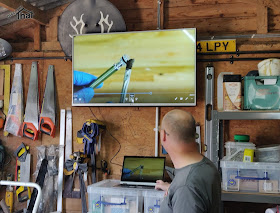My brother, Roy, offered to lend me a dropper post to try out. There was a condition. It needed to be serviced because, at the time, it was not working.
There are plenty of existing
online tutorials, including the
manufacturers videos, to show you how to carry out the service. Roy had already bought the kit of spare parts. Mainly rubber rings and other seals.
The following are bits of information that would have helped us to know, in advance. We might have known this, if we had read other articles!
Read the list of tools. Do not rely solely on the video.
You will need some specialist tools or some way to do the same thing.
None of them are expensive. The bleed tool is the most difficult to find an alternative to. You need something to block the hole but you also need to be able to release it to make sure nothing leaks out.
The 'oil height' tool is only used to suck out any remaining oil up to a level. A carefully held tube in a syringe would be able to do the job adequately. Just don't suck out too much fluid.
The 'IFP height' tool is also not essential but some correctly fitting metal or hard plastic pipe would be necessary. For the price of the tool, I would recommended to use it.
We did not have the appropriate offset spanners to use with a torque wrench. We used care and a guess, based on experience, of how much to tighten. Erring on the side of not breaking anything.
One tricky job is clamping the inner tube without damaging or marking it. We took it apart, very nervously, with it clamped between two flat blocks of wood.
Before we started the re-assembly, I made my own specialist clamp.
For the inner tube of the piston, it needs a 10mm hole, which I drilled in to some hard wood. I cut through the middle of the hole, along the grain, to form the two halves of the clamp. It works well.
While I was at it, I added different size holes.
It took a few hours but we got everything done and back together and working, first time.
Having seen it apart, we know that the cause of the post getting stuck, was only the outer tube. In future we would probably carry out a service just to clean up the outer slide. That can be done without any specialist tools and may not need any replacement parts. Only if that does not work, would we buy the kit and service the hydraulics.
Once serviced it is necessary to bleed the shocks. Rockshox have
another video to explain that.
I have since, fitted it to the bike.
==




























